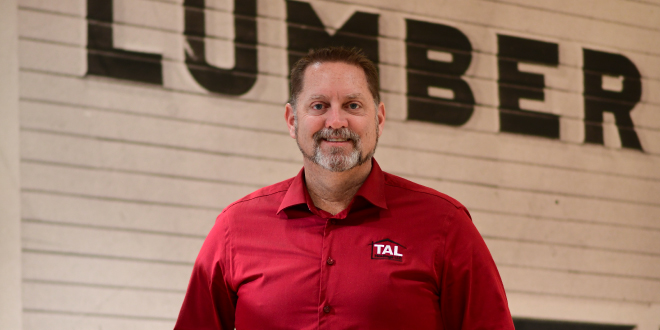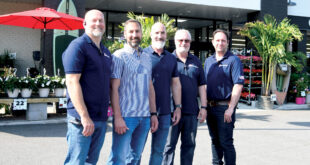Next Chapters: Explore three business transition strategies for your operation at hardwareretailing.com/business-transition-strategies.

Selling an independent family business can be an emotional process, and it can become even more emotional when selling to an outside buyer. Learning where to find an outside buyer, how the acquisition process works and how to best handle all of the challenges and hurdles will help the process go more smoothly and can temper some of the emotions of the transaction.
Hardware Retailing spoke with the previous owner of Badger Building Center, a family-owned company, and the CEO of TAL Holdings, the family-owned outside operation that purchased them, to offer an up-close look at the process of selling and provide best practices for navigating an outside sale.
TAL, an acronym created from the company’s original business, Tum-A-Lum Lumber founded in 1906 by J.M. Crawford, was created in 2012 to better position the operation for growth and is still owned by 4th and 5th generation descendants of Crawford today. Starting with four locations in 2012, TAL encompasses 29 home improvement stores located throughout the Pacific Northwest and employs around 620 workers. Jason Blair, CEO of TAL, has been in the industry since 1991 and joined TAL in January 2022.
Badger Building Center was established in 1983 in Sandpoint, Idaho, by Mike and Sandy Badger and grew to four locations by 2013. Their son, Lee Badger, began working in the operation in 1989 and now holds a senior management position at the Post Falls, Idaho, location following Badger Building Center’s acquisition by TAL in 2021. Blair and Badger share about the sale process and provide insights from both sides of the transaction.
The Lead Up
Like many other independent family-owned businesses, Badger says he and his family had no plans to sell the operation, especially to an outside buyer.
“We didn’t just wake up one morning and say ‘Let’s sell,’” Badger says. “Over the years, we were approached a number of times by different people who were interested in purchasing our business. We really didn’t have any interest and never had a serious conversation with them.”
While the approaches about selling sparked conversations within the family about the future of the company, it wasn’t until Badger met members of TAL in 2019 that the family was inspired to get more serious about the acquisition process, he says.
“Around that time, we hit a point where we wanted to do what was best for our employees by expanding and allowing more growth opportunities than they may have had if we had continued as we were going,” Badger says. “TAL’s family-owned legacy and values aligned with ours, and as we dug deeper, we realized how similar we were to them; they checked every box that was important to our family. We felt comfortable with them, and we were confident they would move our business in the direction we wanted and continue to offer growth opportunities to our employees.”
Blair says with any acquisition, leadership at TAL wants the retailer who is selling their operation to be comfortable with TAL and vice versa.
“It’s important to us that when we make an acquisition, the seller is supportive of what’s going to happen and our cultures fit with one another,” he says.
There are a multitude of ways an acquisition opportunity can present itself.
“Most of our acquisition opportunities have come through some sort of existing relationship within our network of businesses, whether that’s through a direct relationship with the current owners, relationships through the vendor community or occasionally through the broker community,” Blair says. “We’re not typically the ones to reach out to somebody unless we have been alerted they are for sale, but it is a mixed bag as to who reaches out first depending on the circumstances.”
If TAL does reach out, it is because the operation checks all of the company’s boxes for an acquisition.
“When we are vetting opportunities, we are looking for successful companies that have a similar culture fit and a legacy brand like ours,” Blair says. “We seek out good operators in the Pacific Northwest, typically not in large metropolitan areas, who are well-respected and located in an area where we are focused with nice growth potential.”
With the right geography, presence in its community and exceptional culture, Badger Building Center was a good fit, Blair says.
“Badger Building Center also had great leaders in play,” he says. “There’s always going to be some level of change, but when the business is similar to yours, that transition is less jarring.”
Just as no operation is the same, acquisitions can vary greatly. With any acquisition opportunity, the buying cycle could take a few months or a few years and often depends on aspects like the complexity of the deal, the geography and quality of the business.
“Badger Building Center’s acquisition was impacted by COVID-19, so it took a little longer to come together completely,” Blair says. “The process also moved slower because everyone was focused on doing the right thing for their businesses, but it still was not an unusual amount of time for us.”
Before the process began, the Badger family recruited some key players.
“We surrounded ourselves with a good accountant and attorney, as well as a third-party facilitator we knew and trusted who gave advice and worked with the lawyers on both sides of the transaction,” Badger says. “It was very worthwhile to have somebody, beyond an accountant and attorney, who had been through similar business transactions in the past and could aid us through the transaction.”
To gain an understanding of the value of the business, Badger calculated the businesses’ EBITDA, or net income with interest, taxes, depreciation and amortization added back, he says.
“Coming up with a valuation that both the seller and acquirer are comfortable with is critical to the transaction,” Blair says. “Valuations can vary because there are aspects that are subjective, like the value of a brand, and some that are objective, like the value of the equipment. Valuations can also be emotional, so it is critical to be realistic with expectations.”

Counteracting Challenges
Like any part of a business, the acquisition process has challenges. Selling or buying a business requires extra work for everyone involved in the process, and it’s important to expect bumps along the way and for the strong possibility that everything won’t go perfectly.
“Typically the biggest challenge on the buying side is working through all the necessary legal paperwork; it is sometimes overwhelming,” Blair says. “When obstacles present themselves, you should try to handle them as quickly as possible and be open about the expectations around how you’re going to handle them to ensure that they don’t derail the entire process.”
A surprising aspect for Badger was the large number of people involved with the process and how much effort it took to come to closing.
“It’s a very detailed, drawn-out process that forces you to rely on a lot of different people to compile information and produce paperwork so you can get through the closing process,” he says.
Blair says it’s beneficial to take your time and be flexible. He suggests setting dates for when you want steps to happen, but be ready to adjust as you go deeper in the process.
Badger warns about giving enough time to complete the acquisitions as well.
“One challenge we had was time,” Badger says.
“We thought we had given ourselves plenty of time between agreeing on the asset purchase agreement (APA) and closing, but we barely gave ourselves enough time to compile the information necessary for closing.”
While that was one challenge, it wasn’t necessarily the hardest one.
“The biggest challenge for us was the emotional aspect,” Badger says. “We had employees who had been here for over 30 years and there’s a loss of identity when you go from general manager to a regional general manager or all of the sudden you’re not the owner, you’re just another part of the piece that helps the operation move forward.”
It is important to understand there are differences in how each side of the transaction looks at the opportunity and for the buyer to be mindful of the emotion involved, Blair says. Fear and anxiety can become part of the process, so being compassionate is also important.
The Next Steps
Once the acquisition is complete, the work isn’t done yet.
“We had an open line of conversation with our employees, and we leaned into that communication process through the acquisition to make sure our people knew what we were doing, how we were doing it and what the end result was going to look like,” Badger says.
Transparency and open conversations are not only important with acquired employees, they are also vital to a successful melding of cultures.
“Having patience is really important in the process,” Blair says. “We are always mindful of the change that we’re about to embark on for everyone involved, and we want to be very thoughtful about that. We strive to acquire companies that have a great culture, and we want to meld that with our current culture in a way that works well for everyone.”
It was an adjustment being part of a much larger team and being surrounded by more people, Badger says. Badger Building Center’s purchasing team went from two people to nine people and the marketing department went from one person to three people.
“Everything used to go through one person in the organization, and when you become part of a much larger team, there’s a different way to report and function,” Badger says. “It took us a little while to wrap our arms around it, but I feel like we’ve done a very solid job of that and TAL has done a great job of helping us through it to the other side.”
Even though it can cause employees to disengage, Badger says he wishes they could have given staff a softer landing by announcing the acquisition to them earlier.
“We have a wonderful group of employees who are super strong,” Badger says. “They could have looked at this acquisition as a messy change and disappointment, but they really viewed it as a new challenge and endeavored to be the best that they could be through the journey.”
While there will always be ambiguity and uncertainty during this process, leadership can make the difference between a successful transition and a failed one.
“As leaders, it is our job to ensure that we make those new employees who are out there in the trenches interacting with customers, building loads and checking people out at the front counter feel good about what’s going to happen,” Blair says.
Badger says he appreciates the way TAL has respected his company’s history and employees.
“The way both sides have handled the acquisition has allowed our team to adjust as smoothly as you could expect with such a huge change,” he says.
The More You Know
For Blair, the goal of any acquisition opportunity is to learn as much throughout the process and from the retailer as you teach them and create a mutually beneficial relationship.
“My best advice for retailers looking to sell their business is to have clean financials that are easily explained and set clear expectations on the confidential information you’re willing to share, which means having the right NDAs in place,” he says.
In the end, being open, honest and transparent will allow the newly acquired operation to head in a clear direction.
“Be patient and thorough, and be certain that you’re partnering with the right company because they’re not going to go away anytime soon,” Badger says.
“Build up a great staff years ahead of even considering acquisition because a great staff is what will help you get through the process and continue to grow toward a strong future.”
Draft the Right Docs: See what documents you need for a smooth business transition experience at hardwareretailing.com/succession-documents.
Navigating a Sale: Discover eight tips on how to sell or buy a business at hardwareretailing.com/tips-buy-sell.
 Hardware Retailing The Industry's Source for Insights and Information
Hardware Retailing The Industry's Source for Insights and Information








